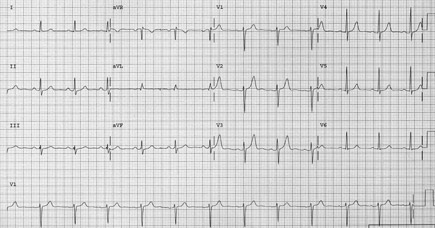MKSAP Quiz: Chest pain of 4 months' duration
A 60-year-old man is evaluated for chest pain of 4 months' duration. He describes the pain as sharp, located in the left chest, with no radiation or associated symptoms, that occurs with walking 1 to 2 blocks and resolves with rest. Occasionally, the pain improves with continued walking or occurs during the evening hours. He has hypertension. Family history does not include cardiovascular disease in any first-degree relatives. His only medication is amlodipine.
On physical examination, he is afebrile, blood pressure is 130/80 mm Hg, pulse rate is 72/min, and respiration rate is 12/min. BMI is 28. No carotid bruits are present, and a normal S1 and S2 with no murmurs are heard. Lung fields are clear, and distal pulses are normal.
An electrocardiogram is shown.

Which of the following is the most appropriate diagnostic test to perform next?
A. Adenosine nuclear perfusion stress test
B. Coronary angiography
C. Echocardiography
D. Exercise treadmill stress test
Answer and critique
The correct answer is D: Exercise treadmill stress test. This question can be found in MKSAP 16 in the Cardiovascular Medicine section, item 1.
The most appropriate test to establish a diagnosis of coronary artery disease (CAD) in this patient is an exercise treadmill stress test. The description of chest pain has both typical and atypical features. Based on the patient's age and sex, the pretest likelihood that his symptoms represent angina are increased, giving him an intermediate pretest probability for CAD. The patient is able to exercise and has a normal baseline electrocardiogram (ECG). In this setting, an exercise treadmill stress test is the most appropriate noninvasive imaging study.
A pharmacologic stress test such as an adenosine nuclear perfusion stress test is useful when a patient cannot exercise because of physical limitations such as arthritis, physical deconditioning, or advanced lung disease and in the setting of an abnormal baseline ECG. Pharmacologic stress agents include dobutamine, dipyridamole, and adenosine. Given that the patient has a normal baseline ECG and is able to exercise, a pharmacologic stress test would not be the correct choice.
Coronary angiography has a small but inherent risk of vascular complications and is therefore usually not the initial diagnostic test used to evaluate a patient presenting with chest pain. For patients with lifestyle-limiting angina despite optimal medical therapy, high-risk criteria on noninvasive stress testing, or successful resuscitation from sudden cardiac death, coronary angiography may be useful.
An echocardiogram would be useful to evaluate left ventricular systolic function (ejection fraction), assess for wall motion abnormalities (that may indicate a previous myocardial infarction), and exclude significant valvular heart disease. A normal echocardiogram, however, would not exclude the presence of underlying CAD and therefore would not be the best test to establish a diagnosis in this patient.
Key Point
- For a patient who is able to exercise and has a normal baseline electrocardiogram, an exercise treadmill stress test is the most appropriate noninvasive study to evaluate for coronary artery disease.



